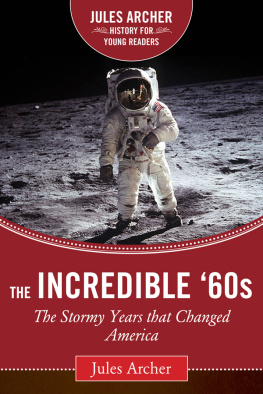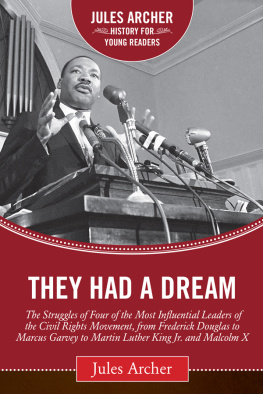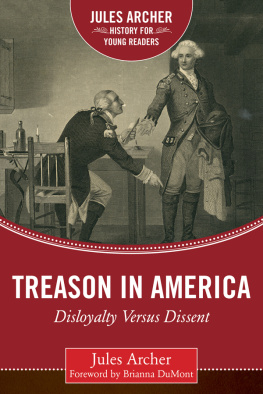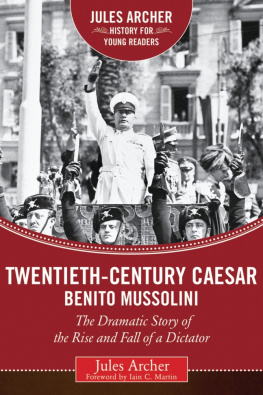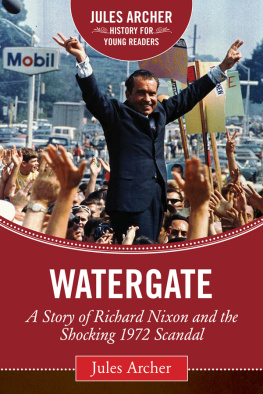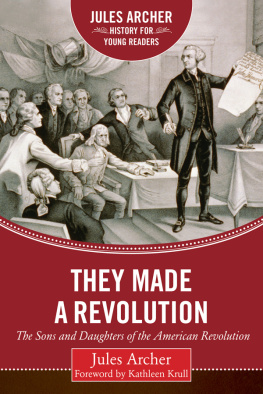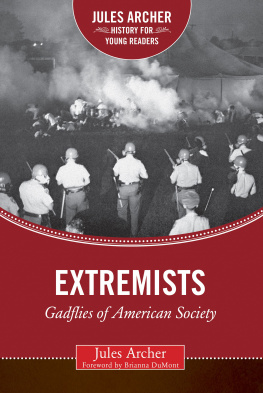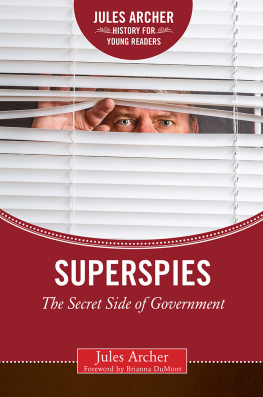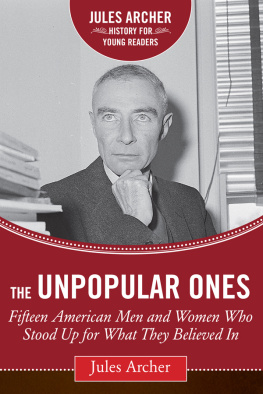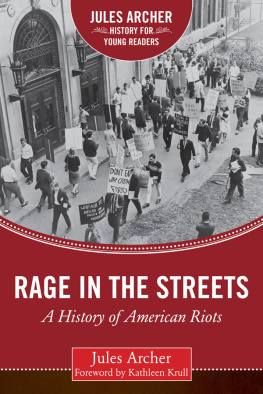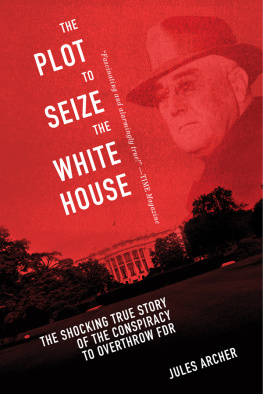Historical texts can often reflect the time period in which they were written, and new information is constantly being discovered. This book was originally published in 1986, and much has changed since then. While every effort has been made to bring this book up to date, it is important to consult multiple sources when doing research.
All photographs from United Press International.
Copyright 1986 by Jules Archer
Foreword 2015 by Sky Pony Press, an imprint of Skyhorse Publishing
First Sky Pony Press edition, 2015
Photo credits: Phillip Galgiani, (bottom); all others, AP/Wide World Photos
All rights reserved. No part of this book may be reproduced in any manner without the express written consent of the publisher, except in the case of brief excerpts in critical reviews or articles. All inquiries should be addressed to Sky Pony Press, 307 West 36th Street, 11th Floor, New York, NY 10018.
Sky Pony Press books may be purchased in bulk at special discounts for sales promotion, corporate gifts, fund-raising, or educational purposes. Special editions can also be created to specifications. For details, contact the Special Sales Department, Sky Pony Press, 307 West 36th Street, 11th Floor, New York, NY 10018 or .
Sky Pony is a registered trademark of Skyhorse Publishing, Inc., a Delaware corporation.
Visit our website at www.skyponypress.com.
10 9 8 7 6 5 4 3 2 1
Library of Congress Cataloging-in-Publication Data is available on file.
Cover design by Brian Peterson
Print ISBN: 978-1-63220-605-3
Ebook ISBN: 978-1-63220-766-1
Printed in the United States of America
In memory of Eleanor Archer,
Dr. Michael and Elizabeth Archer,
Dr. Dane and Mary Fran Archer,
Dr. Kerry and Maureen Archer,
and Dorothy Soul-Ward
CONTENTS
FOREWORD
Reality Was Incredible
1960s America was made by adventure seekers. Some were insiders, in suits and ties, holding government offices and wielding power, telling a story of Americas onward march toward perfection. Others were outsiders in jeans, Army fatigues, and swirling colors, who thought radical changes were needed to make justice and freedom prevail.
America was, by and large, on an adventure kick, as was the Soviet Union. In 1962, Soviet Premier Nikita Khrushchev thought he could secretly place nuclear missiles in Cuba, but this adventure only drove John F. Kennedys government to the brink of a war that could easily have destroyed humanity. Meanwhile, Americas longest, most righteous adventure, in the minds of three successive presidents, Kennedy, Johnson, and Nixon, was a war in Southeast Asia that ended up killing some three million Vietnamese, as well as countless Laotians and Cambodians and more than 58,000 Americans. Communist regimes were gaining power in Southeast Asia, a fact that our leaders feared would shift the political balance and undermine freedom. From the dominant American point of view, Communism in Vietnam, led by Ho Chi Minh, was not an independent nationalist force, rooted in a successful revolt against French colonial power, but an extension of the Communism that ruled China and the Soviet Union. Consequently, our leaders felt that it was the United States duty to intervene, although few of Americas allies agreed.
The presidents who made these decisions were still fixated on World War II. They believed they were fighting on the side of good against absolute evil. So it came to pass that, in 1967, Vice President Hubert Humphrey, formerly a liberal hero for his fight against white supremacy at home, told a military-industrial conference that antiwar marchers were incredibly ridiculous, and boasted that Vietnam would be marked as the place where the family of man has gained the time it needed to finally break through to a new era of hope and human development and justice... This is our great adventure, and a wonderful one it is!
By the time the United States ceased bombing Southeast Asia, it had dropped at least three times the tonnage of bombs that it dropped in all theaters of war during World War II. In the end there were still Communist regimes that came to power regardless of the USs intervention, but Vietnam, Cambodia, and Laos suffered several million mortalities.
Jules Archer is right to remind us that for most of the decade, most of America was in a complacent mood, unwilling to risk much for peace or equality. At the beginning, most Americans felt no need for new civil rights laws even as white supremacy prevailed across the South and blacks were terrorized with impunity. Still, small clusters of protesting risk-takers inspired others, so that by 1963, some hundred thousand Americans risked life, limb, and liberty to rallyalmost always nonviolentlyagainst white supremacy. Even when the killers were tried, many were let off by all-white juries. In 1964, when the state of Mississippi declined to prosecute the killers of civil rights workers James Chaney, Andrew Goodman, and Mickey Schwerner, and a Federal jury was able to convict the killers of violating the civil rights of the threeby murdering themnone of them served more than six years in prison.
The civil rights movement ballooned into a general counterforce challenging abusive and authoritarian institutions of all sorts, from brutal police to a misguided military. The result was a complicated, decentralized, and evolving social invention known as the movement, which was the creation of a quite different set of adventurers. Many had grown up believing that standard-bearers like Hubert Humphrey could be trusted to escort America into a future of equality, justice, and plenty. But as American policies abroad became more recklessly violent, and domestic policies failed to keep pace with demands for equality and dignity, the movement evolved toward distrust, cynicism, and militancy. The movement, or New Left , did not consist of mountain climbers or white-water rafters but life adventurers. They sought justice, knowing that massive and frequently brutal forces were poised to stop them. But it was not only justice that drove them. They were also liberating themselves, seeking to become their own kinds of citizens, unscripted, freed from the confinements of ordinary life, ordinary careers, and Cold War normality.
To the surprise of almost everyone, the relative prosperity that emerged after World War II cushioned youthful rebellionand backlash. Sex, drugs, rock n roll, fantasies of a million sorts went to work against the dominance of American life by government, industrial overreach, male-centered families, corporate discipline, and bureaucratic higher education. What became known as the counterculture overlapped with the New Left, and in the course of the decade, its styles of revolt spread to new populationspeople of color, women, religious groupings, the military, gaysand an environmentalist or ecology movement that opposed the wreckage of nature. Everywhere authorities lost their legitimacy. Spiritual seekers upended conventional faith. Seekers of different sorts, artists and thinkers in all fields, went all out, striving to devise language, imagery, and ritual that might be inventive enough, to express new desires. At the same time, establishments of all sorts, and ordinary conservatives, circled their wagons to fight off weirdos and freaks.
The sixties were, as Jules Archer says, incredible because America had been for too long telling itself false stories. Because of the courage and conviction of the rebels, what erupted were essential questions of how Americans ought to live and what they should value. Those questions remain debatable and fresh because they go to the heart of who we are as a people.

